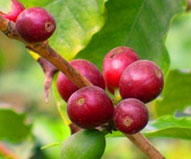Coffee Info:
Wake Up! Here's where your morning coffee comes from. Inside each red, ripe berry on an evergreen shrub found in warm, humid climates are the "beans" that are made into coffee. Once picked, flesh removed and seeds dried, the beans are then roasted to varying degrees, depending on the desired flavor. Decaffeination is done when  the seeds are still green, before they are roasted, by dissolving the caffeine containing oils.
the seeds are still green, before they are roasted, by dissolving the caffeine containing oils.
The degree of roasting has an effect upon coffee flavor and body. Darker roasts are usually a bolder and more sugary flavor. Lighter roasts have a stronger flavor due to the aromatic oils and acids that are otherwise destroyed during longer roasting times. To preserve the freshness of roasted beans, they need to be stored in an airtight container and in a cool, dry and dark place. After the roasting process, the beans are then ground and brewed to create coffee.
There are a couple of ways to ground the coffee beans. A burr grinder is generally the best way because the grind is more even and the grind size can be adjusted. Once ground, the beans are then brewed to create the beverage. The automatic drip coffeemaker heats up hot water, which then seeps through the coffee grounds stored in filter packs, to a pot or carafe beneath. The spent grounds are retained in the filter. To create espresso, a small amount of boiling water is forced with pressure through the finely fround coffee beans, pulling espresso shots into a cup. This also produces a foam called crema. Generally an espresso machine is used. A percolator forcers boiling water under pressure through the grounds into a separate chamber or continually cycle the boiling brew through the grounds using gravity until the required strength is reached. However it is known to over extract the coffee and is therefore not the most popular method for brewing coffee. Another simple method of brewing is with a French press in which coffee is brewed by placing the coffee and water together, stirring it and leaving to brew for a few minutes, then pressing the plunger to trap the coffee grounds at the bottom of the narrow glass or plastic cylinder.
Coffee can be presented in a variety of ways. Drip-brewed, percolated, or French-pressed coffee can be served hot with milk, and sweeteners or chilled as iced coffee. Espresso-based coffee has an even wider range of presentations. There is the basic shot of espresso which can be served alone, alternatively, milk is added in different forms to espresso. Steamed milk will make a Latte, equal parts of steamed milk and milk froth will make a cappuccino. Latte art is done by using the steamed milk to form patterns on the shot of espresso.
The origin of coffee as a beverage dates back about 500 years, when, according to one legend, some goats were restless one night, and the owners traced their restlessness to some nearby coffee bushes, which they had eaten. Then owners then pulverized some beans and threw them into a pot of boiling water. This brew had a great taste and aroma.
In the beginning, the center of coffee production was Yemen, around the city of Mocha. Today, coffee beans from different areas and climates yield interestingly different flavors. Coffee is a brewed beverage and is one of the most-consumed beverages in the wold due to the stimulating effect of its caffeine content and distinct aroma and flavor.
Coffee News:

Recent Studies of Health Benefits of Coffee! In recent years, some 19,000 studies have been done in an attempt to understand the risks or benefits of consuming coffee. What might be more surprising is that recent studies have shown that coffee can actually be good for you. This is good news for the people of America and for the Coffee Industry.

“"Overall, the research shows that coffee is far more healthful than it is harmful," says Tomas DePaulis, PhD, research scientist at Vanderbilt University's Institute for Coffee Studies, which conducts its own medical research and tracks coffee studies from around the world. “For most people, very little bad comes from drinking it, but a lot of good."”
Positive health risks are clear drivers of consumption, so this is good news for coffee stores and coffee store franchises, as consumers are happier to drink more caffeinated beverages. More people now believe that there are health benefits to coffee and that it is good for their health. The results of these findings are that consumers are more confident in purchasing coffee and are increasing their coffee consumption.
Paralyzed Women Drinks Cup of Coffee! Can a mere thought maneuver a robot into fulfilling a wish, even if only to help the person sip from a cup independently? In an unprecedented experiment, a women paralyzed from the neck down was able to drink coffee on her own for the first time since her stroke 15 years earlier. A tiny sensor about the size of a baby aspirin was injected just below her skull, into the part of the motor cortex that regulates movement in the arms and hands. With practice, she learned to move a robotic arm by watching the researchers move the arm and then imagining she was actually controlling it. After a while, she mastered the skill and was able to move the arm by merely imagining she was performing the task.
As she sipped the warm brew, she flashed a victorious smile and the scientists working with her say that they will never forget it. This extraordinary feat marked the first time in which a human with severe brain injury was able to control a prosthetic arm by use of a tiny brain implant programmed to transmit signals to a computer.
Exciting as the discover is, the technology is not yet ready for use outside the lab. Still, the new study is the latest step in proving that brain-controlled prosthetics are closer to reality than ever. Even for drinking that craved for cup of coffee.
